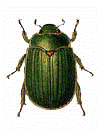Museum, University of Nebraska State
Document Type
Article
Date of this Version
3-3-2004
Abstract
The endangered American burying beetle, Nicrophorus americanus Olivier, presently occurs in small and widely scattered areas on the periphery of its former range. As part of the recovery plan for this insect implemented by the U.S. Fish and Wildlife Service (USFWS), we conducted surveys in Nebraska to ascertain its presence. Additionally, we examined various trapping methods and procedures in the course of our survey work. We compared the effectiveness of different trap designs, trap placement, timing of trapping, types and amounts of bait, and monitoring traps. We also developed methods to reduce beetle mortality in traps. Our work offers more effective sampling procedures for N. americanus and suggests the current USFWS sampling protocol should be modified. New procedures include larger traps, moist soil substrate, a soil berm to the edge of the trap, longer trapping season, and increased distances between traps. A moist soil substrate, in combination with a shade-giving rain cover, precludes the necessity of servicing all traps by 9 AM each day (as mandated in the current protocol), a task that is logistically difficult or impossible if there are many traps. The sampling procedures we have identified as most appropriate for N. americanus will also improve sampling for other silphid species.



Comments
Published in The Coleopterists Bulletin, 58(1):57–70. 2004. Copyright 2004 Jon C. Bedick, Brett C. Ratcliffe, and Leon G. Hogley.